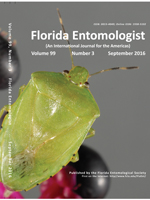Nephaspis oculata (Blatchley) (Coleoptera: Coccinellidae) is a predatory lady beetle that has been studied for biological control of whiteflies. Here, we studied the feeding rate and development of this beetle on rugose spiraling whitefly, Aleurodicus rugioperculatus Martin (Hemiptera: Aleyrodidae), an invasive whitefly species that was first found in the United States in 2009. The objective of our study was to measure the feeding rate of N. oculata on rugose spiraling whitefly and compare the egg-to-adult development on eggs and nymphs. Our results showed that N. oculata is able to complete its development from egg to adult solely on rugose spiraling whitefly. At 26.7 °C, immature (1st to 4th instars combined) beetles consumed an average of 245.7 ± 14.4 rugose spiraling whitefly eggs prior to pupation. Adult beetles consumed 50.6 ± 1.8 eggs per day. There was no difference between the feeding rate of adult males and females or between immature males and females. Larvae searched for prey by sweeping the leaf surface in an arc-shaped area around them. Extra-oral digestion was observed during feeding, which involved withdrawing and regurgitating of fluids from and into the egg shell. It took 21.3 ± 0.7 d for the beetles to develop from egg to adult. The feeding rate of N. oculata on rugose spiraling whitefly was compared with that on Bemisia tabaci (Gennadius) (Hemiptera: Aleyrodidae) at the same temperatures based on data from the literature. Adults of N. oculata consumed significantly lower number of eggs when fed on rugose spiraling whitefly compared with B. tabaci. However, rugose spiraling whitefly eggs are 3.7 times larger than B. tabaci eggs so the actual daily volume of rugose spiraling whitefly eggs consumed was 1.7 greater. Females of N. oculata produced significantly more adult progeny when fed on rugose spiraling whitefly eggs compared with rugose spiraling whitefly nymphs. Therefore, rugose spiraling whitefly eggs could be considered a more suitable choice than nymphs for rearing N. oculata. Results of our study may help researchers to determine suitable beetle-to-whitefly release ratios and to improve rearing methods of this beetle.
How to translate text using browser tools
1 September 2016
Feeding and Development of Nephaspis oculata (Coleoptera: Coccinellidae) on Rugose Spiraling Whitefly (Hemiptera: Aleyrodidae)
Siavash Taravati,
Catharine Mannion,
Lance Osborne,
Cindy McKenzie

Florida Entomologist
Vol. 99 • No. 3
September 2016
Vol. 99 • No. 3
September 2016
Aleurodicinae
biological control
Control biológico
Florida
lady beetle
mariquita




